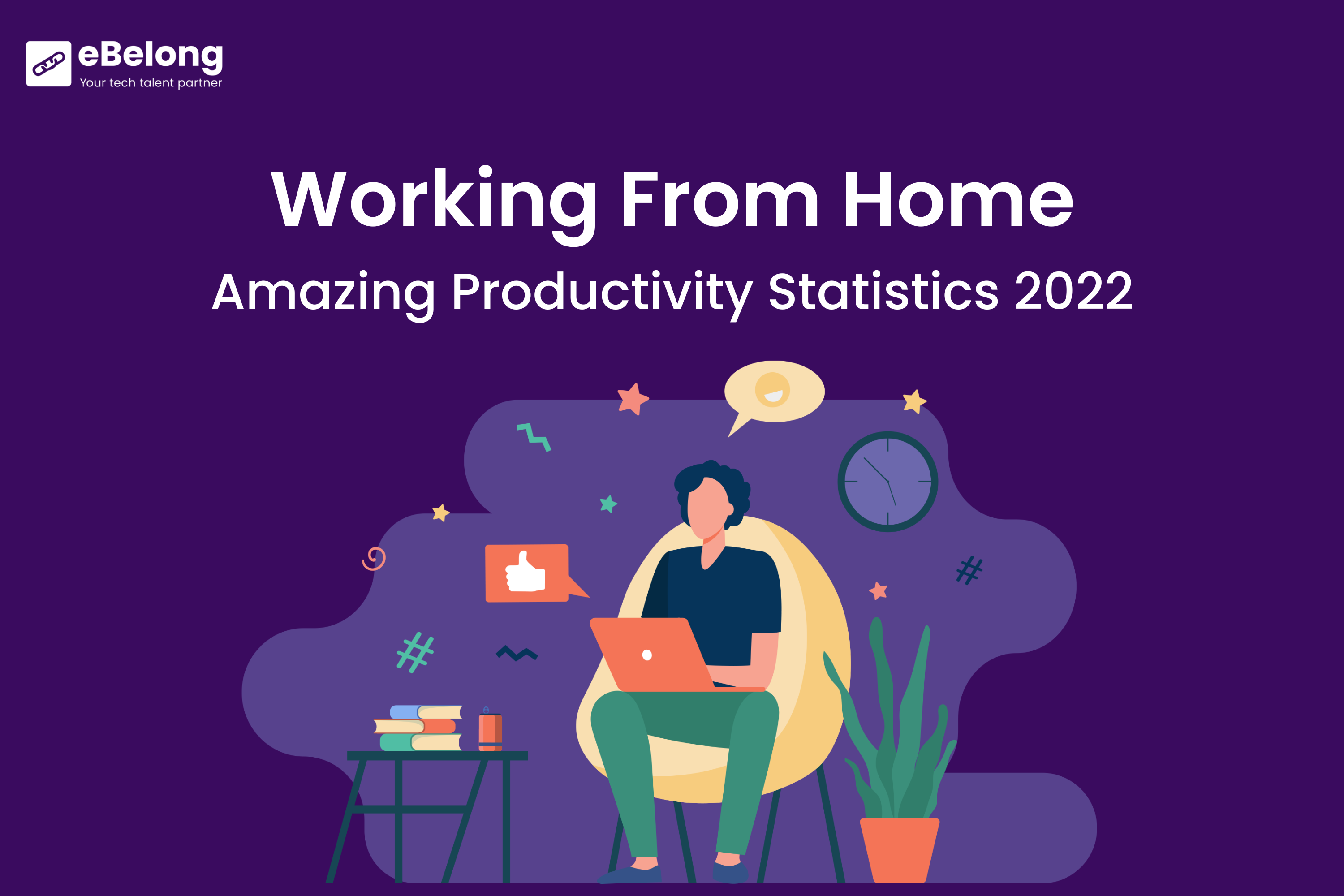Amazing Working From Home Productivity Statistics 2022
The work-from-home workforce is evolving as more people learn about non-human contact employment alternatives. Businesses must adjust to the fact that the majority of non-essential employees work from home. Could working from home be more productive in the midst of a pandemic?
According to an Upwork prediction, over 26% of the American workforce, or 1 in 4 people, will be working remotely by the year 2021.
According to a research by Owl Labs, in 2021, 70% of people who worked from home during the pandemic indicate that virtual meetings are less stressful, and 64% now prefer hybrid meetings.
Over the past few months, a number of studies have shown that working remotely from home increases productivity more than working in an office environment. Those who work from home are typically 10 minutes less unproductive per day, work one additional day per week, and are 47% more productive.
People who work from home are more reliable, put in more time, and accomplish more during a workweek. This doesn't sound right at all.
How may working from home help you concentrate better? Learn how professionals who don't work in an office environment are able to do more.
Working from home can improve performance by up to 13%
Working from home boosts productivity by 13%, according to a Standford study of 16,000 employees over a 9-month period. This improvement in performance was brought about by more calls being made per minute due to a more comfortable and quiet working environment, as well as by working longer shifts with fewer breaks and sick days.
Employees in the same survey indicated higher levels of job satisfaction and a 50% reduction in attrition rates.
Remote work can boost productivity by up to 77 percent
According to a ConnectSolutions poll, 77 percent of those who work remotely at least occasionally report higher productivity, with 30 percent producing more work in less time and 24 percent producing more work in the same amount of time.
Prior to COVID-19
Many businesses have been hesitant to allow employees to work from home because they think it will reduce productivity. This isn't completely incorrect. It's simple to become sidetracked, put off tasks, or work less diligently from home than at the workplace.
According to a 2019 research by the Bureau of Labor Statistics, 24% of persons with jobs conducted part or all of their work at home on days they worked, while 82% of people with jobs did some or all of their work at their place of employment.
According to the same study by the Bureau of Labor Statistics, employees in professional and related occupations (33%) and financial operations, business, and management (37%) were more likely to work partially or entirely from home on days when they were employed than employees in other occupations.
According to a 2012 study, office workers who were given tedious duties performed more quickly and accurately in the typical office environment. When you don't enjoy your job, home distractions are more likely to keep you from doing productive work.
However, this study discovered that more creative labour produced more fruitful outcomes. In other words, a task will be finished more quickly the fewer restrictions that are placed on it.
The same study also demonstrates that if everyone works from home, the "office" as a whole will perform worse. Every person will put in the same amount of effort as the one before them. No one wants to put forth more effort while the others take advantage of them.
According to a different, more recent study, those who work from home more frequently become less productive. People who work from home full time (8 hours a day) are 70% less productive than people who don't.
Following COVID-19
Since 2012, a few things have changed. It is now simpler to work from home, and communication tools are improving.
According to polls conducted in the last few months, working from home results in faster project turnaround times and more productivity.
The first six months of stay-at-home orders in 2020, from March to August, were compared to the same period in 2019, by Great Place to Work. A two-year research involving 800,000 employees found that remote job productivity was either maintained or enhanced when done from home.
According to Prodoscore, productivity has increased by 47% since March 2020 (in comparison to March and April 2019), and they have figured out when people are most productive.
According to the survey, employees are most productive on Tuesdays, Thursdays, and between 10:30am and 3:00pm. Even though the typical workweek still runs from 8:30 am to 5:30 pm, more employees are using email and customer relationship management programmes to communicate with one another.
Only 65% of Americans, according to a Stanford report, have internet that is fast enough to support video conversations. 26 percent of Americans work at their employer's physical site, while 42 percent do so from home.
According to a March 2020 Airtasker poll, employees who work from home spend 15% less time avoiding it, work 1.4 more days per month, and take 15% longer breaks.
Employees who work from home claim that their coworkers are less likely to distract them, that they spend 30 minutes less chatting about things unrelated to their jobs, and that they spend 7 percent less time talking to management.
Nathan Schultz, a senior executive at Chegg, was questioned by The New York Times about productivity at the company now that the labour is sheltered at home.
His initial reaction was to constantly check in on the workers, but as soon as he relaxed, production increased and workers began doing tasks ahead of schedule.
Even while production has increased, this does not guarantee that it will continue to be so. According to the same NYT piece, some businesses are reporting that their staff members struggle with the absence of social interaction. Employee happiness will gradually decrease as productivity is hampered by poor mental health.
In the first few months of quarantine, businesses like Splunk, Affirm, and Microsoft experienced a significant increase in productivity. However, over term, the isolation of working from home had a negative impact on both productivity and job happiness.
For this reason, a hybrid work paradigm is now being adopted by many businesses.
Boosting productivity while working from home
Working from home instead than in an office is a significant change. Where can you work efficiently at home? How do you maintain focus? What time should you begin and end? How will this change how you live at home?
The following advice will help you or your staff operate from home more successfully:
Make your workspace cosy. Working in an office encourages focus and accountability. Attempt to duplicate this workspace in your house, whether by adding a desk behind the sofa or converting a spare room into an office. The area should be cosy, free of additional screens (TV, Xbox, etc.), and equipped with everything you need to finish your work.
Stay Organized. To make sure you stay on schedule, you might need to start utilising a day planner or adopt a new organisational strategy. It is advised that you make a weekly work schedule and include a list of the duties you have to do. Maintaining your commitment to the plan will assist you in developing consistency and a routine.
Decide to work in shorter but more intense intervals.. When you concentrate intensively for shorter periods of time, you might be more productive. Time how long you can work without becoming distracted for a few hours. For instance, if you can focus for 30 minutes without becoming sidetracked, keep up this pace the entire day. Set an internet timer for 30 uninterrupted minutes of work following each break.
Take breaks. Your brain may relax and refocus by taking regular rests. According to the Airtasker poll, taking regular breaks is the best strategy to stay productive for 37% of the remote workers. Get a snack, a drink, some fresh air, or check on your family during your break. A remote worker takes 22 minutes of breaks during the day on average.
Take a virtual commute. The New York Times claims that the isolation and lack of social interaction that come with working from home are its most challenging aspects. Checking in with coworkers throughout your routine commute can promote social connection and help you concentrate on the day's job.
In a Nutshell
Depending on your set-up, working from home can be more productive than sitting in a standard office cubicle and improving work-life balance. As a result of the current pandemic, more businesses are turning to at-home remedies.
Make sure your staff members are relaxed, well-organized, and in good health to ensure that their output meets company requirements for months to come.
Ebelong assists employers in finding eCommerce, marketing design, and IT talent as one of the top employment firms for developers. Get in touch with us to learn more about our IT staffing or hiring remote developers..


